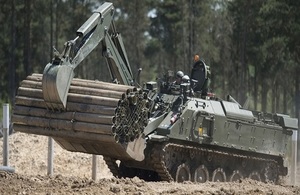
On behalf of the British Army, we are trying to better understand the current market capability in meeting this challenge in order to fully scope and better design a potential future concept demonstration event or competition. This will provide us with an understanding of what potential gap crossing solutions already exist as well as emerging novel solutions. This request for information is not a commitment to subsequently launch a formal DASA competition.
Background
Gap crossing is critical in maintaining military mobility. In the past this capability has been delivered by specialist equipment and systems, however it is perceived that with changes in materials and manufacturing techniques, combined with the changing operational landscape, there is an opportunity to do things differently. The current capability is delivered through obstacle crossing techniques including the use of fascine (bundled plastic pipes or tubes tethered together, used to cross natural or man-made gaps which could be dry or wet) and conventional bridging.
What we want
Technologies with the potential to meet the system characteristics highlighted below (either fully or partially).
Requirement – A single system enabling both tracked and wheeled platforms to transit the following:
- A dry gap – no more than 3m deep and of a width between 3-6 m
- A wet gap – water of an unspecified depth and flow rate not exceeding 2 m/s, with a width between 3-6 m.
System characteristics
| Essential | Desirable |
|---|---|
| Capable of bearing a Military Load Class (MLC) of up to 100(T). | Rapidly deployable, with a target time of 3 minutes. |
| Remotely deployable. | If non-recoverable, it should not present an environmental hazard. |
| Enables transit for vehicles with a range of track width (2.0 m - 4.2 m). | If deployed from a vehicle, it should be capable of being stowed and deployed from multiple different platform types. |
| Easily transportable without adversely affecting vehicle operability (lethality / survivability / mobility), if the solution is to be stowed on a vehicle. | If recoverable, recovery should be achievable with minimal additional resources, using no additional mechanical lifting equipment. |
| Weight minimised in order to avoid excessive increase to transporting vehicle MLC. Ideally a single complete system should weigh no more than 500 kg and be made up of sub-components weighing no more than 100 kg. | If recoverable, it should be capable of a number of redeployments, considering value for money in that number. |
| Operates in a variety of environments and temperature ranges (-40 to +50 degrees centigrade). |
What we don't want
We are not interested in literature reviews, paper-based studies, consultancy, non-technical solutions or marginal improvements to existing capabilities. This is not a competition and therefore we are not asking for costed proposals at this stage. This is a market engagement request for information exercise and we do not commit to subsequently launch a formal DASA competition.
How to submit a Capability Submission Form
Complete DASA Capability Submission Form - Crossing The Gap (MS Word Document, 888KB)






